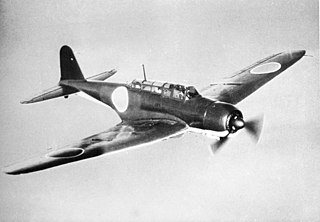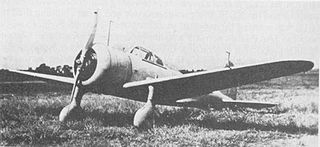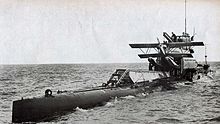
A modern torpedo is an underwater ranged weapon launched above or below the water surface, self-propelled towards a target, and with an explosive warhead designed to detonate either on contact with or in proximity to the target. Historically, such a device was called an automotive, automobile, locomotive, or fish torpedo; colloquially a fish. The term torpedo originally applied to a variety of devices, most of which would today be called mines. From about 1900, torpedo has been used strictly to designate a self-propelled underwater explosive device.

A maritime patrol aircraft (MPA), also known as a patrol aircraft, maritime reconnaissance aircraft, maritime surveillance aircraft, or by the older American term patrol bomber, is a fixed-wing aircraft designed to operate for long durations over water in maritime patrol roles — in particular anti-submarine warfare (ASW), anti-ship warfare (AShW), and search and rescue (SAR).

The I-400-class submarine Imperial Japanese Navy (IJN) submarines were the largest submarines of World War II and remained the largest ever built until the construction of nuclear ballistic missile submarines in the 1960s. The IJN called this type of submarine Sentoku type submarine. The type name was shortened to Toku-gata Sensuikan. They were submarine aircraft carriers able to carry three Aichi M6A Seiran aircraft underwater to their destinations. They were designed to surface, launch their planes, then quickly dive again before they were discovered. They also carried torpedoes for close-range combat.

The Mitsubishi A5M, formal Japanese Navy designation Mitsubishi Navy Type 96 Carrier-based Fighter (九六式艦上戦闘機), experimental Navy designation Mitsubishi Navy Experimental 9-Shi Carrier Fighter, company designation Mitsubishi Ka-14, was a WWII-era Japanese carrier-based fighter aircraft. The Type number is from the last two digits of the Japanese imperial year 2596 (1936) when it entered service with the Imperial Navy.

The Nakajima B5N was the standard carrier-based torpedo bomber of the Imperial Japanese Navy (IJN) for much of World War II. It also served as a high level bomber.

The Aichi M6A Seiran is a submarine-launched attack floatplane designed for the Imperial Japanese Navy during World War II. It was intended to operate from I-400 class submarines whose original mission was to conduct aerial attacks against the United States.

The Kyūshū Q1WTōkai was a land-based anti-submarine patrol bomber aircraft developed for the Imperial Japanese Navy in World War II. The Allied reporting name was Lorna. Although similar in appearance to the German Junkers Ju 88 medium bomber, the Q1W was a much smaller aircraft with significantly different design details.

The Type 96 25 mm gun was an automatic cannon used by the Imperial Japanese Navy during World War II. A locally-built variant of the French Hotchkiss 25 mm anti-aircraft gun, it was designed as a dual-purpose weapon for use against armored vehicles and aircraft, but was primarily used as an anti-aircraft gun in fixed mounts with one to three guns.

The Nakajima Ki-27 was the main fighter aircraft used by the Imperial Japanese Army Air Service up until 1940. Its Allied nickname was "Nate", although it was called "Abdul" in the "China Burma India" (CBI) theater by many post war sources; Allied Intelligence had reserved that name for the nonexistent Mitsubishi Navy Type 97 fighter, expected to be the successor to the carrier-borne Type 96 with retractable landing gear and an enclosed cockpit.

The Yokosuka E14Y was an Imperial Japanese Navy reconnaissance seaplane transported aboard and launched from Japanese submarine aircraft carriers such as the I-25 during World War II. The Japanese Navy designation was "Type 0 Small Reconnaissance Seaplane" (零式小型水上偵察機).

The Kawasaki Ki-60 was an experimental Japanese pre-World War II fighter aircraft that used a license-built (Kawasaki) DB 601 liquid-cooled engine. This was at that time an unusual choice because the majority of Japanese aircraft at that time used air-cooled radial engines.

The Kyūshū K11W Shiragiku made by the Kyūshū Aircraft Company, was a land-based bombing trainer aircraft which served in the Imperial Japanese Navy Air Service in the latter years of World War II. As indicated by its Japanese designation, "training aircraft for on-board work", it was designed to train crews in operating equipment for bombing, navigation, and communication, as well as navigation techniques. A total of 798 K11Ws were manufactured, including a small number of K11W2 ASW and transport aircraft alongside the K11W1 trainer variant. These aircraft were also used in kamikaze missions during the last stages of the Pacific War.

Anti-submarine warfare is a branch of underwater warfare that uses surface warships, aircraft, submarines, or other platforms, to find, track, and deter, damage, or destroy enemy submarines. Such operations are typically carried out to protect friendly shipping and coastal facilities from submarine attacks and to overcome blockades.

The Yokosuka H5Y or Yokosuka Navy Type 99 Flying Boat Model 11, given the allied code name Cherry, was an IJNAS flying boat in service from 1938.

An aerial torpedo is a torpedo launched from a torpedo bomber aircraft into the water, after which the weapon propels itself to the target.

The Kokusai Ki-76, or Liaison Aircraft Type 3, was a Japanese high-wing monoplane artillery spotter and liaison aircraft that served in World War II. The Allied reporting name was "Stella".

The Mitsubishi Ki-18 was an unsuccessful and unsolicited attempt by Mitsubishi to meet a 1934 requirement issued by the Japanese Army for a modern single-seat monoplane fighter suitable to the needs of the Imperial Japanese Army Air Force. During this competition, Nakajima entered the Nakajima Ki-11, and Kawasaki entered the more maneuverable Kawasaki Ki-10 biplane. The competition was won by Kawasaki, but the new fighter was not accepted by the IJAAF with much enthusiasm.

Nisshin (日進) was a seaplane tender (AV) of the Imperial Japanese Navy during World War II.
The Yokosuka E6Y was a Japanese submarine-based reconnaissance seaplane developed at the Yokosuka Naval Air Technical Arsenal for the Imperial Japanese Navy during the 1920s. The prototype first flew as the Yokosho 2-Go in 1929.
I-368 was an Imperial Japanese Navy Type D1 transport submarine. Completed and commissioned in August 1944, she served in World War II and was converted into a kaiten suicide attack torpedo carrier in January 1945. She was sunk in February 1945 while operating during the Battle of Iwo Jima.



















